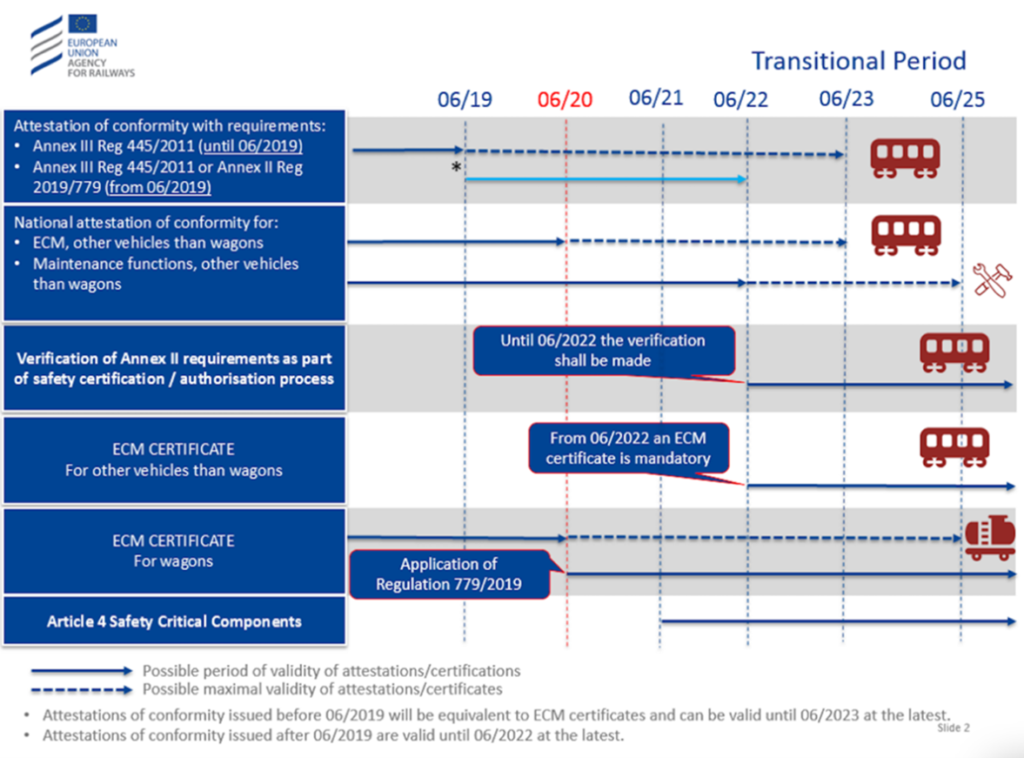News and terminology
From 16 June 2022, owners of locomotives will also have to present an ECM certificate for their vehicles. The acronym ECM stands for “Entity in charge of maintenance” and describes the entity responsible for maintenance. ECMs registered for these vehicles in the European Railway Agency Database for Interoperability and Safety (ERADIS) register must comply with the provisions of the European Safety Directive and the corresponding implementing regulation.
Does this also affect you?
This new regulation affects members of the VAP who have their own locomotives for shunting services in their sidings. However, the implementing regulation excludes the following vehicles from its scope:
- Steam locomotives and historical vehicles
- Locomotives or vehicles that run within the siding without entering the station via the siding with flank protection
- Two-way vehicles
This means that you do not need ECM certification either for the use of two-way vehicles or for the use of locomotives exclusively within the sidings. If, on the other hand, your locomotives run outside the flank protection in transfer tracks of the station, you must obtain an ECM certificate for them.
Caution when waiving certification
Important to know: If a locomotive without an assigned ECM is to be taken to the workshop, you must arrange a special transport for it with an appropriate operating concept. Alternatively, you can carry out a piggyback transport on a lorry. There are therefore certain disadvantages to not having ECM certification.
ECM certification
Locomotive owners can either seek ECM certification themselves or delegate the ECM function to a service provider. The following companies offer support, both for certification and for taking over the ECM function for locomotives:
- Bahn-Support GmbH / philipp.schneider@bahn-support.ch / T +41 (0)44 808 78 07
- Müller Technologie AG / a.simonetta@mueller-technologie.ch / T +41 (0)52 557 91 56
- Sersa Group AG / rudi.hoz@rsrg.com / T +41 (0)43 322 23 41
- Siemens Mobility AG / ruben.andre@siemens.com / T +41 (0)79 951 38 24
Legal basis
Directive (EU) 2016/798 on railway safety and the updated implementing regulation (EU) 2019/779 of 16 May 2019 regulate the uniform requirements for ECMs. The regulation now provides for a scope of application for all types of vehicles. Included are the vehicle categories freight wagons, locomotives, multiple units, passenger coaches, high-speed vehicles, construction/maintenance vehicles and others.
Transitional provisions
The following transitional provisions apply to existing certificates and attestations of conformity under the old ECM Regulation 445/2011:
ECM function and exemptions
An ECM certification certifies that the requirements of the Implementing Regulation are met. In the context of issuing the safety certificate for railway undertakings (RUs) or safety authorisations for infrastructure managers, corresponding ECM certificates may also be issued. These apply to RUs and infrastructure managers that are entered as ECMs in the register for their own vehicles and maintain these vehicles exclusively for their own operations. Accordingly, these vehicles are not freight wagons and do not run in other trains. In this case, the RU or the infrastructure manager cannot perform an ECM function for other vehicles. For ECMs responsible for the maintenance of freight wagons, certification is mandatory without exception. Any entity certified for the relevant scope can act as a registered ECM.

